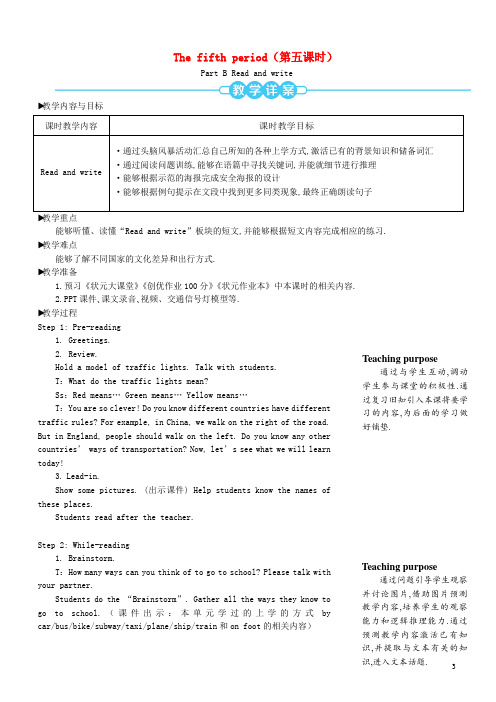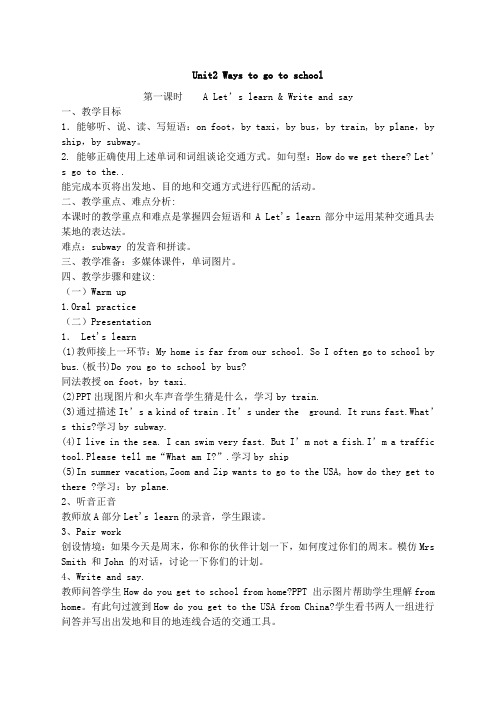六年级英语unit2第五课时
- 格式:doc
- 大小:20.50 KB
- 文档页数:2


The fifth period(第五课时)Part B Read and write▶教学内容与目标课时教学内容课时教学目标Read and write ·通过头脑风暴活动汇总自己所知的各种上学方式,激活已有的背景知识和储备词汇·通过阅读问题训练,能够在语篇中寻找关键词,并能就细节进行推理·能够根据示范的海报完成安全海报的设计·能够根据例句提示在文段中找到更多同类现象,最终正确朗读句子能够听懂、读懂“Read and write”板块的短文,并能够根据短文内容完成相应的练习. ▶教学难点能够了解不同国家的文化差异和出行方式.▶教学准备1.预习《状元大课堂》《创优作业100分》《状元作业本》中本课时的相关内容.2.PPT课件、课文录音、视频、交通信号灯模型等.▶教学过程Step 1: Pre-reading1. Greetings.2. Review.Hold a model of traffic lights. Talk with students.T:What do the traffic lights mean?Ss:Red means… Green means… Yellow means…T:You are so clever! Do you know different countries have different traffic rules? For example, in China, we walk on the right of the road. But in England, people should walk on the left. Do you know any other countries’ ways of transportation? Now, let’s see what we will learn today!3.Lead-in.Show some pictures. (出示课件) Help students know the names of these places.Students read after the teacher.Step 2: While-reading1. Brainstorm.T:How many ways can you think of to go to school? Please talk with your partner.Students do the “Brainstorm”. Gather all the ways they know to go to school.(课件出示:本单元学过的上学的方式by car/bus/bike/subway/taxi/plane/ship/train和on foot的相关内容)Teaching purpose通过与学生互动,调动学生参与课堂的积极性.通过复习旧知引入本课将要学习的内容,为后面的学习做好铺垫.Teaching purpose通过问题引导学生观察并讨论图片,借助图片预测教学内容,培养学生的观察能力和逻辑推理能力.通过预测教学内容激活已有知识,并提取与文本有关的知识,进入文本话题.32.Look and predict.Show the pictures of “Read and write” on the PPT.(课件出示:教材P18 Read and write板块的图片)Let students observe the pictures,read the dialogue and discuss the questions.Questions:①Who are they? (Robin and Wu Yifan’s grandpa. And the grandpa is ill.)②What does Robin want to do? (He wants to read a magazine to the grandpa.)③What’s the magazine about? (Different ways to go to school in different countries.)3.Listen and say.(1)Show the four pictures one by one. (课件出示:依次出示教材P18 Read and write板块的四幅图片) Let students observe the pictures and discuss the questions.Questions:①Who are they? (They are students/kids/children.)②Where are they? (In Munich, Germany. In Alaska, USA. In Jiangxi, China. In Papa Westray, Scotland.)③How do they go to school?Let students read the text quickly and find the ways of the children to go to school.(2)Play the recording. (课件出示:教材P18 Read and write板块的音频)Let students listen to it and answer the questions below the passage in the book.(3)Check the answers.4. Learn the new words and sentences.(1)Play the recording again. (课件出示:教材P18 Read and write 板块的音频) Lead students to learn the new words and sentences.①Show the picture of the sled and do the action to help students understand the phrase “by sled”. (课件出示:雪橇图片)Do the action fast first, then do the same action slowly. Let student s understand the word “fast”.Ask students to do and say the sentences “Some kids go to school by sled. It’s fast.” “Don’t let the dogs run too fast. You must drive slowly.”②Show the pictures of a boat, a ferry and a ship on the PPT. Teaching purpose引导学生带着问题阅读文本,整体感知文本,获取有用信息.利用问题逐步引导学生理解文本,逐步跟随文本学习新句型.Teaching purpose运用任务型教学方法,设计不同的任务,环环相扣,逐步引导学生跟随文本学习新词汇、新句型,对重点句型进行认知和操练,突破教学重点,降低学习的难度.5Help students und erstand the differences among “ship, boat and ferry”.Do the action and teach the phrase “by ferry”. Wear a life jacket to help students understand the sentence “We must wear a life jacket by ferry. And don’t run on the ferry.”Write down the sentence str ucture “Some kids go to school by…” on the blackboard. Do the actions and let students use the sentence structure to make sentences.③Lead students to look at Picture 4. Ask them to read the sentences and try to answer the questions.T :How do the children in Papa Westray go to school? Ss :By ferry.T :How did they go to school in 2009? Ss :By plane. T :Why?Ss :Because the ferry didn’t work.(2)Play the recording. (课件出示:教材P18 Read and write 板块的音频) Let students read after the recording. Pay attention to the pronunciation and the intonation.5. Read and choose.(1)Let students practice the passage. (2)Let students act out.(3)Let students retell the ways of the kids to go to school in groups by looking at the pictures.(4)Let students give some suggestions for the kids.Divide students into six groups. Let them read the suggestions on page 19 one by one. Then ask them to choose the suitable suggestions for the kids and write them down on page 18.6. Practice the words and the sentences. (1)Play the game of “Drive the train”.Make up a chant of the words and the phrases.Ask students to chant it one by one in lines. Give a sticker to the student who does a good job.Teaching purpose播放录音,让学生听录音跟读.引导学生按照正确的意群及语音、语调朗读对话.Teaching purpose利用插图引导学生分组复述原文.最后,带领学生阅读后文给出的关于选择不同交通方式的建议,引导学生对前文的孩子们的不同的出行方式提供合适的建议.(2)Play the game of “Roll the snowball”.Lead students to practice the key sentences “Some kids go to school on foot./By sled, you must drive slowly./On foot, don’t go at a red light.”Make students stand in a line. Let the first student say the first word “some” of the sentence. Then the second student says “somekids”. The third student says “some kids go” …Students say till the last student speaks out the whole sentence “Some kids go to school on foot.” Once one of the students says it wrong, the team loses the game. Oppositely, the team can get a sticker if all the students say it correctly.Step 3: Post-reading1. Play the recording of “Tips for pronunciation”. (课件出示:教材P19 Tips for pronunciation的音频)Let students listen and compare, then find out the rule of pronunciation. Tell students the law of linking sounds. Ask students to listen again and repeat. Then let students find and say more words like these from the text on page 18.2.Do a survey.(1)Make a model:A: How do you go to school?B: I go to school by/on…(2)Let students ask and answer in groups. Finish the chart. (课件出示:调查表) Then let the group leader make a report with the sentence structure “… goes to school by/on…”3. Make a poster.(1)Let students list the ways of the group members to go to school.(2)Let students write down at least two suggestions for each way. Make a modal:By ferry, you must wear a life jacket. / Don’t run on the ferry.(3)Let students make a poster in groups.(4)Show time.▶板书设计▶作业设计1.Read after the recording.Teaching purpose滚雪球游戏可以锻炼学生的快速反应能力,让学生在游戏中进一步巩固所学知识,加深对本课重点词汇和句型的理解,体现在玩中学、学中玩的思想,让学生在课上及时吸收消化所学知识.Teaching purpose利用小组调查活动,创造学生说英语的机会,使学生能够在实际情景中运用核心词汇和句型.Teaching purpose紧密联系前面布置的小组调查活动,环环相扣,让学生能够在熟练运用核心词汇和句型之后,自由设计海报,学以致用.2.Do the exercises. (见“状元成才路”系列丛书《创优作业100分》或《状元作业本》对应课时作业)▶教学反思1.在本堂课中,以学生为主体、训练为主线,开展多类型的小组活动,使学生在学中用、用中学.学用结合,激发学生的多元智能学习能力.2.这节课以句型教学为主,配以简单的词组来运用所学句型.采用chant、滚雪球等多种形式来逐步引导学生操练词汇和句型,有效地帮助学生巩固重点词汇和句型.3.呈现活动设计丰富,易操作,且具备层次感,有效地提升了学生的核心素养.以学生为本,以解决问题为导向,引导学生自主学习.4.突出语用功能,联系学生和班级的实际情况,设置多个环节,环环相扣,层层深入,帮助学生在真实情景中.自然地使用所学语言Read and write·Gather all kinds of ways to go to school they know through the brainstorm and activate the background knowledge and the vocabulary they have learned.·Be able to find the key words in the text and reason about details through solving the problems below the text.·Be able to complete the design of a safety poster according to the demonstration poster.·Be able to find more similar sentences in the passage according to the example sentence prompt and read the sentences correctly.▶Teaching Priorities·Be able to listen and read the passage and complete the corresponding exercises according to the passage.▶Teaching Difficulties·Be able to learn about the cultural differences and the ways of travelling in different countries. ▶Teaching Procedures7(续表)9。



PEP Book 7 Unit 2 Ways to go to schoolB Read and writeBy Chen Xiaoqun from Lubei Primary School Ⅰ Teaching content and analysis:本课是PEP教材六年级上册Unit 2 Ways to go to school第五课时。
本课要求学生会阅读小短文,复习巩固本单元重点词汇和句型,然后做读后回答问题的活动。
教师在教学中应注意训练学生按照意群阅读的习惯。
本节课是一节阅读课。
教学中采用“阅读前-阅读中-阅读后”的三段式阅读教学形式,让学生在“粗度-细读-通读”的过程中,培养从阅读中提取信息的能力、按意群阅读的能力,并培养学生对阅读的兴趣和自信心。
Ⅱ Teaching aims:nguage aims:①学生能够在图片的帮助下读懂短文,能回答课后的两个小问题:How many ways to go to school can you find in the text?Does everyone in the text go to school?。
②学生能够运用正确的语音、语调朗读文本,初步感受连读。
2.Ability aims and emotional aims:①能够了解不同国家学生上学的交通方式。
②学生能够进一步提高从阅读中提取信息的能力和按意群阅读的能力。
Ⅲ The important and difficult points:1.The important points:①学生能够在图片的帮助下读懂短文,能回答课后的两个小问题:How many ways to go to school can you find in the text?Does everyone in the text go to school?。
The difficult points:①学生能够按意群阅读。

Unit2 Ways to go to school第一课时 A Let’s learn & Write and say一、教学目标1.能够听、说、读、写短语:on foot,by taxi,by bus,by train, by plane,by ship,by subway。
2. 能够正确使用上述单词和词组谈论交通方式。
如句型:How do we get there? Let’s go to the..能完成本页将出发地、目的地和交通方式进行匹配的活动。
二、教学重点、难点分析:本课时的教学重点和难点是掌握四会短语和A Let's learn部分中运用某种交通具去某地的表达法。
难点:subway 的发音和拼读。
三、教学准备:多媒体课件,单词图片。
四、教学步骤和建议:(一)Warm up1.Oral practice(二)Presentation1. Let's learn(1)教师接上一环节:My home is far from our school. So I often go to school by bus.(板书)Do you go to school by bus?同法教授on foot,by taxi.(2)PPT出现图片和火车声音学生猜是什么,学习by train.(3)通过描述It’s a kind of train .It’s under the ground. It runs fast.What’s this?学习by subway.(4)I live in the sea. I can swim very fast. But I’m not a fish.I’m a traffic tool.Please tell me“What am I?”.学习by ship(5)In summer vacation,Zoom and Zip wants to go to the USA, how do they get to there ?学习:by plane.2、听音正音教师放A部分Let's learn的录音,学生跟读。
课时5Read and write ~Story time一、判断下列图片与短语是否相符,相符的画“”,不相符的画“”。
1. by sled2. by ferry3. by train4. a life jacket二、选出下列每组单词中不同类的一项。
【同类词记忆法】() 1. A. ferry B. sled C. by() 2. A. Germany B. China C. school() 3. A. read B. drive C. child() 4. A. run B. fast C. slowly() 5. A. snowy B. drive C. go三、单项选择。
() 1. Some children go to school________ ferry every day .A. onB. byC. with() 2. Let me read this________ you .A. inB. atC. for() 3. Everyone in our school________ to school on time .A. goB. goesC. going() 4. I________ go to school . I learn at home .A. aren′tB. don′tC. am() 5. You________ stop at a red light . 【抓关键信息法】A. mustB. can′tC. don′t四、用所给词语的适当形式填空。
I, child, slow, not go, snow1. ________at the red light!2. Let________ do it for you .3. —What′s the weather like today?—It′s________.4. Many________ in our class go to school on foot .5. You must drive________.五、根据表格内容,模仿例句造句。